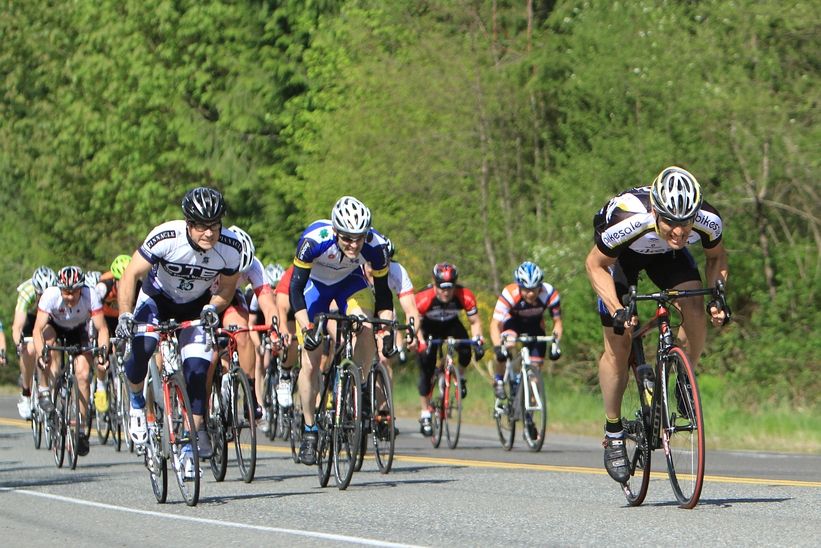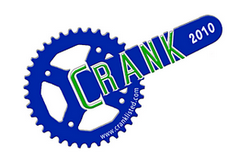The Sprint
Or more specifically, being in the right place at the right time in the last 200m of the course, involves many factors. You may have teammates working with you, or you may be working for the designated sprinter on your team. Either way, it’s hard work coupled with a good sense of timing. In this post I’ll refer to material from Serious Cycling, The Lance Armstrong Performance Program, and Racing Tactics for Cyclists.
One factor initially determine the skills of a sprinter, and that is the preponderance of fast-twitch muscle fibers. This is a genetic trait. Some of us have it, and some of us don’t. But that’s not the only indicator, learned skill is the other factor, and according to Burke, it is often the deciding one.
There are some guidelines to use in the organized chaos that we call bunch sprinting. As the pack approaches closer to the finish, 5k, 1k, and 200m, their group behavior will change. Teams will try to organize to put their sprinter at the 150m-200m mark ready and clear to make his charge to the line. This process is usually called a lead-out. Basically, teams that are organized orient themselves in a single pace line. Their sprinter will be second from the back of the line. Their sweeper will be last. The sweeper’s job is to keep the opposing teams men from drafting-off the sprinter. Depending on how far out the pace line is from the finish, the lead men will either rotate through or pull as hard as they can for a distance and then fade-off. The idea is to keep the speed high enough to discourage other attacks while at the same time conserving the energy of the sprinter. It’s not a good idea to start the lead-out too early…you’ve got to have something left for the finish. Don’t ask me how I know this.
As the train draws closer to the 200m mark or so, the sprinter will start to drive the last lead-out man. The sprinter is in the best position to see what the other teams are doing. If another team tries to surge past, the sprinter can “steer” his lead and reduce the amount of open road in front of the other group. If his timing’s right, the sprinter can shut the other team down and make his bid for the line at the same time his lead transitions off. Team trains often drag-race each other to the finish line. If someone gets nervous and makes a bad move, things can go bad in a hurry. During the Chapman Lake race last season, I was in the middle of the pack front when a rider about two places ahead got sideways. The next five seconds saw about twelve racers go down in a blur of bikes and bodies. All I remember is going over the bars and waking up on the side of the road.
Lead-outs sound great in a perfect world right? I mentioned situational awareness in a previous post. Trying to manage your own energy state (or lack thereof), the positions and energy states of your competitors, and the course layout can be daunting. But we’re paying money to do this right? So we’re having fun. If it’s uphill or windy, delay your jump, likewise, if it’s downhill or a tailwind is blowing, make your move earlier since the sprint will be faster.
But what if you’re the only guy from your team near the front? Here’s where we have to pay even more attention. There are a few types of racers at the front near the finish of a course: those who are struggling and just want to finish, those who won’t contest the sprint because they believe they can’t do it, and those who are strong and willing enough to lay it on the line. Our solo, thinking racer will identify the fast guy and position themselves for the draft. He’ll likely have selected the right gearing too. The idea is to be in a gear that allows you quickly jump and shift-up as you accelerate. If you can’t grab the fast guy’s wheel, stay near the front but on someone else’s wheel. At the right time, if the racer in front of you turns his head to look back, attack on the opposite side…his realization may open enough of a gap to give you the advantage. Let’s say though that the pack gets nervous and picks-up speed early, as each surge passes you might have to jump to a wheel a number of times. The dicey part is everyone else will be doing the same thing in an effort to get to a good position.
“If you’re leading, save a double-kick to foil a drafter behind you. As he steers to either side to make his move, tap that second-to-last kick to expose him to less draft and more headwind. If you’re outside the 200m mark, you can also use the road/lane width to make his drafting less efficient.” It may be enough drag to drain any sprint from him.
There’s a lot happening near the finish line of a race, just remember that the race isn’t over until the finish line is crossed. The next time you watch a recorded racing video, count how many times the lead changes in the last 100m. You might be surprised at the count. I’ll summarize with Thomas Prehn’s review:
- There has to be at least one person to lead-out the sprinter
- The final lead-out person has to drop off the sprinter at 150m-200m to the finish line.
- In a pace line lead-out save enough energy to get back into the pace line.
- Watch for “waves” that could get you or your teammate boxed in.
- The sprinter directs the lead-out
I should mention the skill of throwing your bike at the line since it is a technique that wins countless races. However, in order to do this you have to get to the finish line to execute it, which was the whole purpose of the above. I’ll save this topic for another post.
Keep the rubber-side down.







Leave a comment